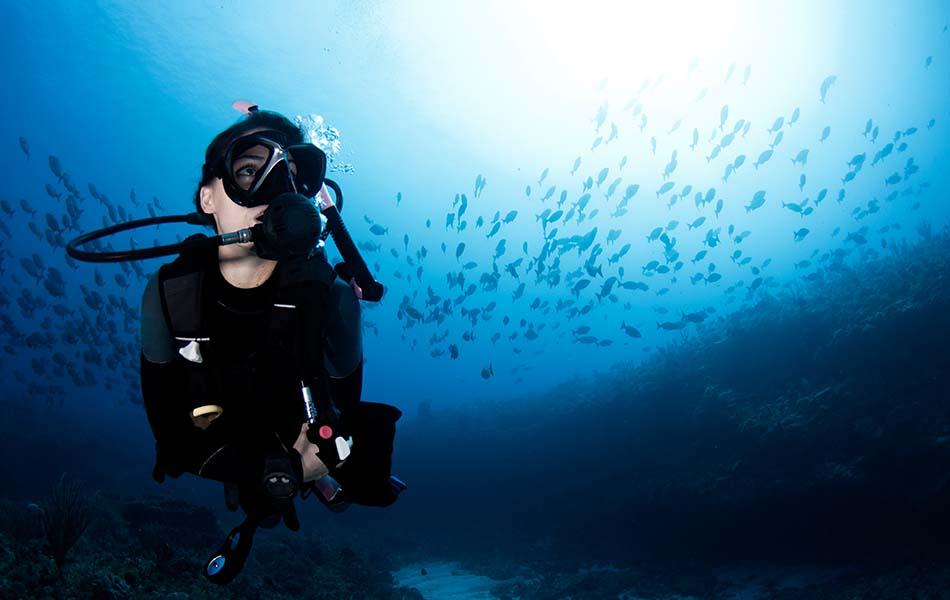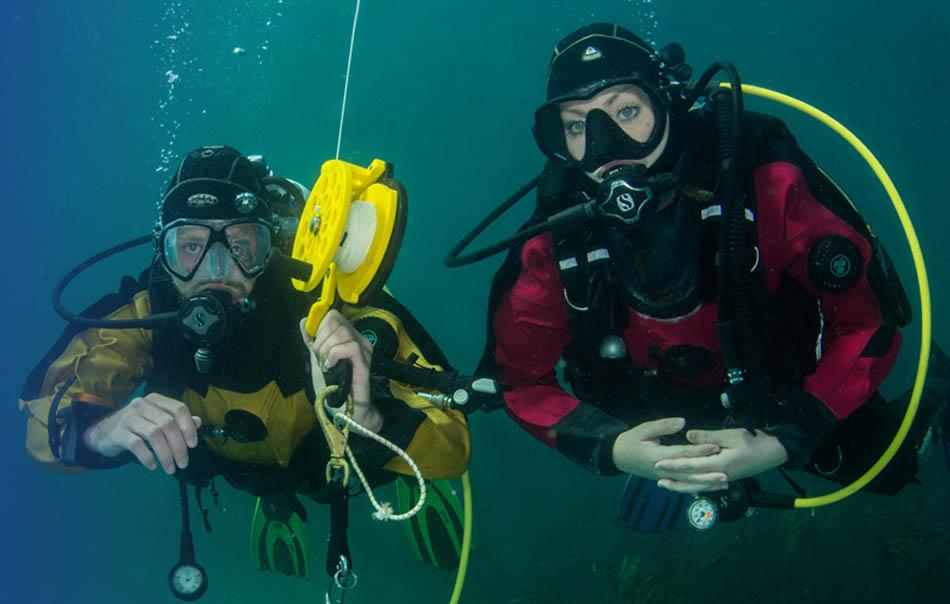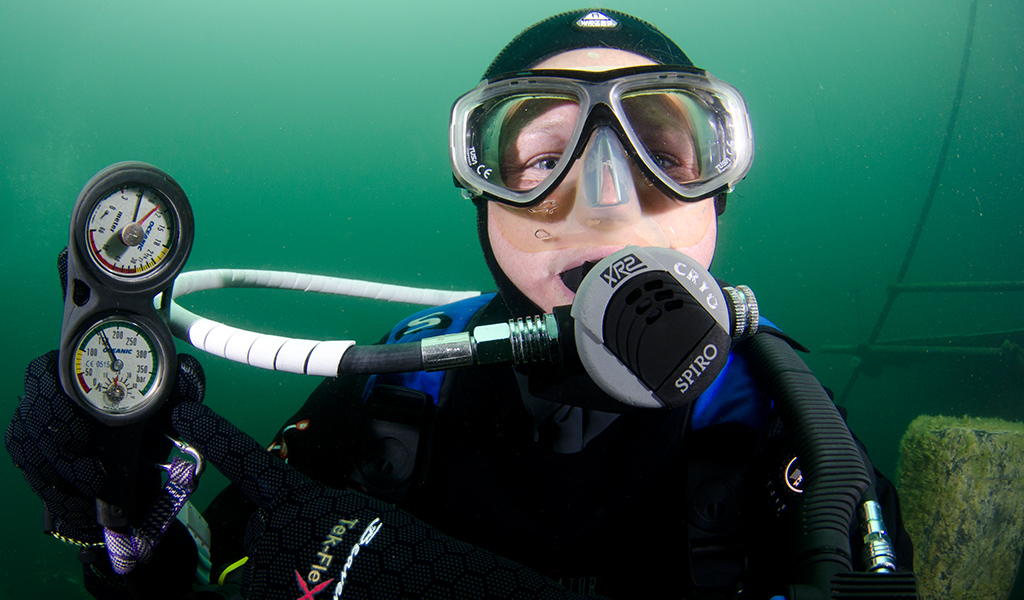
National Instructor Marg Baldwin looks at the factors that influence how much breathing gas you use and how to improve.
Whether you use a lot of gas or a little on a dive, it isn't a competition with your diving buddies. What is helpful is to take a look at what influences your gas consumption. From the first time you put your head underwater wearing scuba kit, you are taught to monitor your gas during a dive using the rule of thirds. Often a Dive Manager records how much gas you have at the start of a dive and how much you come out with. In and around all this good gas management, the question often arises of why two divers on the same dive have such different gas consumption. The answer is infinitely variable. We all differ, and every dive can be different. A good starting point for a discussion is who you are.
Man vs. woman
Are you: a man or a woman; older or younger; experienced or inexperienced; fit or fitness questionable; slim or overweight? Is your natural breathing rate slow or fast? Any one of these factors can have an impact on gas consumption, so let's look at them and I will let you decide which may apply to you.
The lung volume of adult women is typically 10-12% smaller than that of men of the same height and age. Lung capacity influences how much gas we breathe and consequently our overall gas consumption. Add to this the school of thought that women move the water more efficiently than men and the gas-saving is increased. In practical terms from my own experience in recreational diving, if I have a 10-litre cylinder and a male buddy has a 12-litre cylinder (both with the same working pressure), during gas checks we will find that at any stage in the dive our pressure gauges are reading about the same. So he is getting through his 12 litres of gas in the same time it takes me to use 10 litres. On your next dive, observe your buddies, male and female. Do you notice any differences in their gas consumption and possibly in their positioning in water?
Inexperienced vs. experienced (the effect of nerves)
Cast your mind back to the first time that you put your head underwater and breathed from a regulator. Somewhere in the back of your head, a gremlin might have been saying, "Will this thing keep working? I'd better take a deep breath just in case." Something of this kind happens with many new divers, they are naturally nervous about the underwater environment and their breathing rate increases. During pool training, usually their breathing rate will settle and their gas consumption reduces. That is until the first open water dives when the apprehension can kick in again and gas consumption will increase.
Being nervous or apprehensive doesn't just happen to inexperienced divers, it can happen to anyone. Experienced divers usually know or can predict when apprehension is likely, and this helps them manage the situation. I am thinking about the first dive after a layoff. Perhaps in early spring when you get back into the water, our confidence and overall diving fitness are not at the levels they were after a season of diving. Increased air consumption is a frequent outcome.
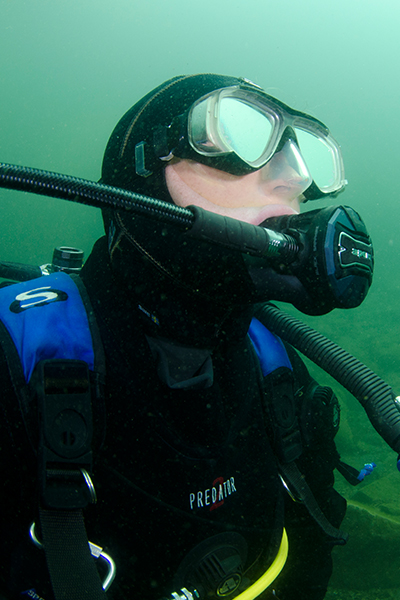
Comfort zones and major kit changes
From time to time, you may go outside our comfort zone. No matter how experienced you are, nerves can click in and influence your gas consumption. The trigger could be a totally unknown dive site or diving with a significantly more experienced buddy whose ability you revere.
A major change in equipment and, perhaps, method of diving can have the same impact. I have seen this happen with an experienced diver under tuition making the move from a back-mounted twin set to diving side-mount. During the shallow dive, the diver was visibly nervous and making basic mistakes; his gas consumption significantly increased. Slowly, he adjusted to the new kit configuration and his breathing rate settled. The key is to recognise that new things can, and will, influence our gas consumption, and plan accordingly.
Diving fitness
Fitness does affect gas consumption. There are different levels of fitness to consider: general overall fitness; dive fitness (diving regularly to the depth and conditions of the planned drive); fitness to dive that day (well-rested and hydrated).
For general fitness, you don't need the levels of an Olympic athlete. A physically fit diver has enough aerobic capacity, cardiovascular health and physical strength to meet the demands of the diving environment. Ask yourself: could I swim against a current? Could I do a long surface swim? Can I help a buddy in an emergency? Answer yes to these questions and it sounds as if you are fit to dive. Diving regularly and maintaining our diving ability is also important, and to further assist our fitness we should participate in other activities such as walking and cycling.
As well as this and diving fitness, make sure that you fit for every dive; meaning well-rested, nourished, hydrated and not suffering from the effects of drugs or alcohol. If anything reduces your level of fitness, your body will not perform efficiently which, in turn, will increase how much gas you use.
Breathing rates
The normal breathing rate for an adult at rest is 12-20 breaths per minute. To breathe efficiently underwater, we should develop a controlled, long, slow breathing style, pulling the gas deep into our lungs with each inhalation and then expelling it in a long, slow exhalation. Ideally, each inhalation should last for 5-7 seconds, and each exhalation at least 7 seconds. A breathing cycle of around 12-15 seconds leads to a very efficient breathing rate of about 4-5 breaths per minute. This takes practice to achieve, and being relaxed and comfortable in the underwater environment is the starting point. When thinking about your breathing rate underwater do not be tempted to skip breathe, the name for holding your breath between inhales and exhales. This can lead to a build-up of carbon dioxide in your blood as well as being against one of the basic rules of scuba diving: do not hold your breath.

How much gas do you use?
Let's do the maths. Gas consumption is often measured as the surface air consumption rate (SAC) in litres per minute. BSAC Diver Training Programme uses 25 litres per minute as an average surface breathing/consumption rate and a suitable starting point for any calculations. Knowing the depth of the dive and absolute pressure (in bar), and the number of minutes spent at that depth, you can complete a basic calculation of how much gas you could use on a dive.
An example: A diver breathing 25 litres of gas per minute, spending 10 minutes at 20 metres (at three bar absolute pressure) will use:
25 x 10 x 3 = 750 litres of gas for that section of the dive
Don't forget that rule of thirds means that this is two-thirds of the gas required and you need to add a third extra to allow for an appropriate reserve.
750/2 x 3 = 1,125 litres of gas needed for that section of the dive
You can divide your planned dive into appropriate sections, repeat the calculations and add together the answers to work out your total gas requirement. Careful monitor monitoring of your gas consumption over a series of dives - noting down start and end pressure in your cylinders, depth and time - will enable you to calculate your own SAC, which may well be less than 25l/min. But, keep in mind the many factors that can influence how much gas you use during a dive.
Your buddy
A regular buddy is often someone you have met during training. A friendship develops through the bond of diving and you are very likely to enjoy the same type and style of diving. Mutual trust develops together with an understanding and knowledge of how we each dive and react to different situations. When diving with a regular buddy you are more likely to be relaxed and comfortable, and this is usually reflected in improved gas consumption. Put a diver with someone they don't know too well or have never dived with before and it is likely their gas consumption will increase. Should that different buddy be someone you respect, maybe even someone you are a little in awe of because of their diving prowess, this can cause you stress and at the time you least want it to happen, you use more gas.
Being buddies with your life partner can, and frequently does, bring its own issues. It can be that your partner makes your ideal buddy; on the other, any minor concerns can be magnified in the underwater environment and translate into a stressful, gas-guzzling dive. It is not unheard of for partners to ask not to be 'buddied' together for this reason.
So far, everything has been rather personal, but there are some other factors to consider that are directly linked to diving ability and equipment.
Buoyancy and trim
We all know to add weight as we move from freshwater to the sea. Do we remember to adjust in reverse when, as the winter storms at sea approach, we move to inland diving? Truthful answer: not always and as a result, you can finish up diving overweighted. Go in overweighted and your buoyancy can immediately go awry. For an overweighted diver, every aspect of the dive can become an effort, possibly leading to overexertion. And with that, gas consumption can and often will significantly increase.
Good buoyancy is key, no matter whether you are a recreational scuba diver or a technical rebreather diver. The ability to glide through the water in a horizontal position, neutrally buoyant, using the minimum effort, having no impact on the environment, is something we all strive for. Achieving neutral buoyancy throughout a dive means we are usually putting in the minimum effort, and consequently our gas consumption will reduce. Every time you make a change to your equipment, it is appropriate to do a weight check. Remember two checks are needed one at the start of the dive and second one at the end of a dive with low cylinder contents.
Thinking about the type, how much, and where we wear our weight is important too. There are many options available: standard or harness weight belts; buoyancy compensators with integral weights or with weight trim pockets; ankle weights; and of course lead weights of different sizes and form, such as blocks or lead-shot pouches.
How much weight we use, and where we carry it, is very important. Time spent adjusting trim is essential for achieving good positioning and neutral buoyancy throughout a dive.
Skills and drills
The introduction of new skills is highly likely to increase a diver's gas consumption. This applies to both new divers practising basic skills, such as mask clearing, and experienced divers moving on to new and more complex equipment such as twin sets and learning how to do gas shutdowns. Achieving any skill requires some effort and concentration and can include an element of stress. All these factors will lead to an increase in gas consumption and in some instances an alarming one. Instructors beware! Equally when practising skills for yourself, do remember to monitor your gas closely. We are all encouraged to practice skills regularly so that they become natural, fluent, and an integral part of our diving. When skills can be performed in a relaxed comfortable state there will be little or no impact on how much gas you use.
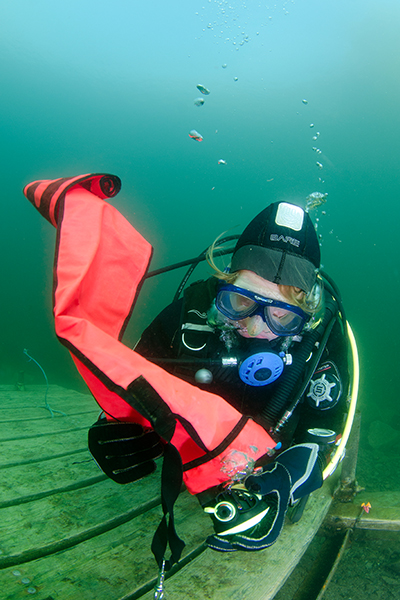
Go with the flow
Drift dives can be beautifully relaxing, allowing the current to take you along at a steady pace over the seabed. Your gas consumption is likely to be low; how wonderful. How many times does a drift start in this manner then the seabed topography unexpectedly changes and the current speeds up and maybe makes a significant change of direction? The impact on us and our breathing rate can be quite dramatic. Likewise, on a wreck, one section can be shielded from a current and the other side can be exposed. Finning against a current for even a short period can substantially increase your gas use.
Being warm and comfortable leads to a slow, steady breathing rhythm that really helps reduce gas consumption. Starting to feel cold and uncomfortable can rapidly create a different situation, which is something to be very mindful of at this time of year. Be ready to adjust your thermal protection and, as appropriate, your weighting and trim. Even having taken those actions be prepared for colder water to increase your breathing rate and the speed at which you use your gas.
Beware task loading
On many dives we find ourselves deploying a delayed surface marker buoy (dSMB). This is usually towards the end of a dive to let the surface cover know you are returning to the surface. Deployment of a dSMB can affect gas consumption in two ways: the effort of completing the skill unless we are very proficient, and the inflation method used - an alternate air source. We should manage our gas to allow for this potential increase in consumption towards the end of a dive.
Dives where you are towing an SMB, or laying a distance line underwater, are highly likely to increase your gas consumption and this must feature in your dive planning. Underwater during such dives, we should be extra vigilant on our gas management. If searches and surveys feature in the dive plan, then the gas planning must recognise that performing such tasks underwater can significantly increase our gas consumption.
Rescue scenarios
Many of us will have read in the pages of SCUBA the impact on the amount of gas used when a diver is involved in an underwater incident, either as the diver in difficulty, or the diver carrying out a rescue. A stressful situation can easily increase a diver's gas consumption to double the norm or significantly more. In any stressful situation, terminating the dive with a slow steady ascent direct to the surface is an appropriate action.
Maybe you do use significantly more, or less, gas than your buddy, but remember it is not a competition. What is important is that you know and understand what influences your gas consumption. Simply put, aim to be: fit for every dive; relaxed and comfortable; neutrally buoyant; and able to move slowly through the environment in a streamlined and controlled manner. All this will help you to have enough gas to bring your dive to its planned conclusion.
Join the fun, find your local BSAC club or join BSAC online today.
Not yet a BSAC member? Let us help you find your local BSAC club
Send your postcode to hello@bsac.com and we'll help you find the right scuba club for you. Or if you fancy a chat call us 0151 350 6226 (Mon - Fri, 9 - 5:30).
This Learning Curve article was originally published in SCUBA magazine, Issue 99 February 2020. For more membership benefits, visit bsac.com/benefits.
Image credit: Simon Rogerson
Images in this online version may have been substituted from the original images in SCUBA magazine due to usage rights.

 Author: Marg Baldwin | Posted 24 Feb 2020
Author: Marg Baldwin | Posted 24 Feb 2020



